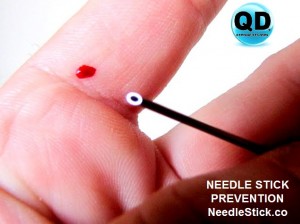 Johns Hopkins research suggests least-skilled providers at risk for life-threatening infections Medical students are commonly stuck by needles – putting them at risk of contracting potentially dangerous blood-borne diseases – and many of them fail to report the injuries to hospital authorities, according to a Johns Hopkins study published in the December issue of the journal Academic Medicine .
Johns Hopkins research suggests least-skilled providers at risk for life-threatening infections Medical students are commonly stuck by needles – putting them at risk of contracting potentially dangerous blood-borne diseases – and many of them fail to report the injuries to hospital authorities, according to a Johns Hopkins study published in the December issue of the journal Academic Medicine .
Researchers surveyed surgery residents at 17 medical centers and, of 699 respondents, 415 (or 59 percent) said they had sustained a needlestick injury as a medical student. Many said they were stuck more than once. Of the surgeons-in-training whose most recent needlestick occurred in medical school, nearly half of them did not report their injury to an employee health office, thereby avoiding an evaluation as to whether they needed treatment to prevent HIV or hepatitis C . It is estimated that 600,000 to 800,000 needlesticks and other similar injuries are reported annually among U.S. health care workers and there is evidence of vast under reporting, says Martin A. Makary, M.D., M.P.H., an associate professor of surgery at the Johns Hopkins University School of Medicine and lead researcher for the study.”Medical schools are not doing enough to protect their students and hospitals are not doing enough to make medical school safe,” he says. “We, as a medical community, are putting our least skilled people on the front lines in the most high-risk situations. Most trainees are still forced to learn to sew and stitch on patients, which puts both providers and patients at risk.” Makary says medical schools should take advantage of advances in simulation technology and do less training on actual human beings until they are more skilled.
The authors of the study believe that needlesticks go unreported due to cumbersome reporting procedures, fears about poor clinical evaluations by their by their superiors, or embarrassment. The most commonly given reason in the study for why the medical students didn’t report needle injuries was the amount of time involved in making a report. The survey did find, however, that medical students were very likely (92 percent) to report the needlestick if the patient was at high risk for having a virus like HIV or hepatitis, compared with 47 percent of injuries involving low-risk patients. Still, prompt reporting of all needlestick injuries is critical to ensuring proper medical prophylaxis, counseling and legal precautions, Makary says. Very few people who follow proper protocol and seek treatment after a needlestick get sick, he says. “Hospitals are not creating a culture of speaking up,” says Makary, who is also the Mark Ravitch Chair of Gastrointestinal Surgery and director of the Johns Hopkins Center for Surgical Outcomes Research. “If people are not speaking up regarding their own safety concerns, it’s probably a surrogate marker of people not speaking up about patient safety concerns.” Most of the needlesticks among medical students were self-inflicted and occurred in the operating room when the student felt rushed. Makary says that needlestick injuries in surgery can infect patients since the providers’ blood can enter the patient’s wound. He argues that hospitals need to create a culture of reporting errors and stop placing their newest trainees at the greatest risk for infection. He also says that since medical students are at significant risk of personal injury during clinical training, more needs to be done to educate them about the importance of reporting any needlesticks, the value of post-exposure treatment and on how to prevent future injuries.
At The Johns Hopkins Hospital, for example, a hotline has been instituted for all occupational blood exposures. After such a report is received, a rapid response team is activated to deliver appropriate care while preserving confidentiality. The study was supported by the Mr. and Mrs. Chad Richison Foundation and the Lotus Global Health Foundation. Source: Johns Hopkins Medical Institutions
Read this article:
Potentially dangerous needlestick injuries often go unreported
____________________________________